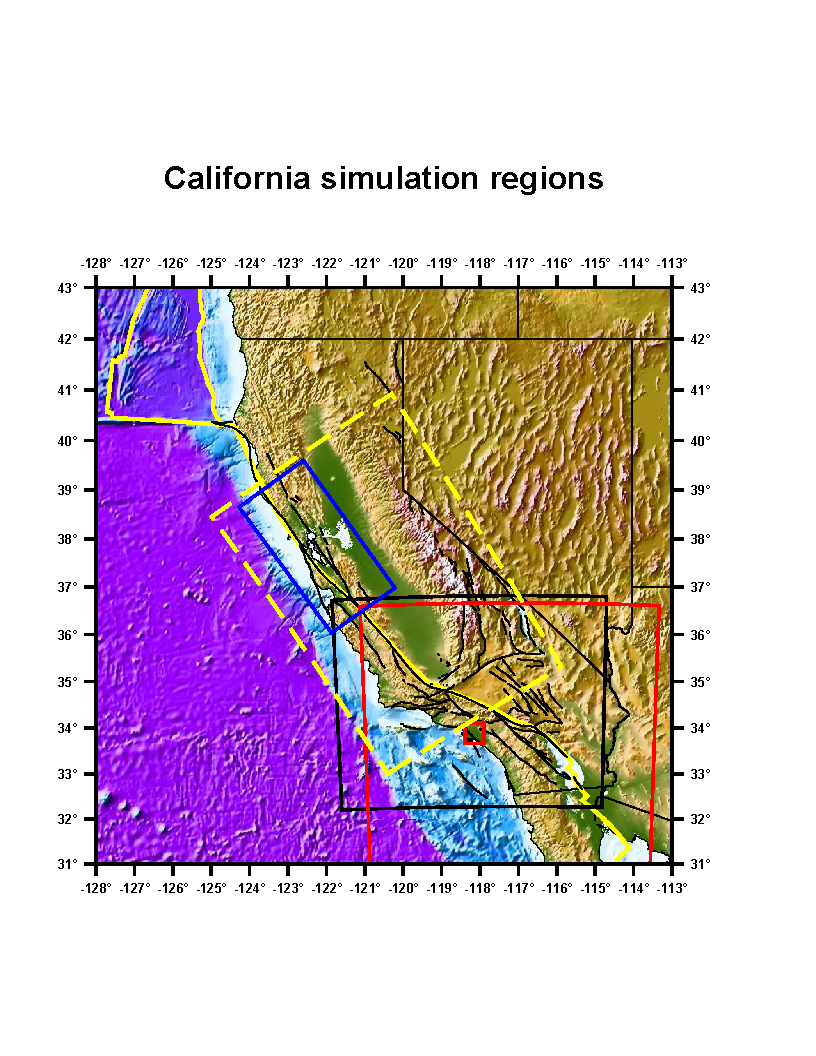Difference between revisions of "UCVM Users Guide"
| Line 30: | Line 30: | ||
== Summary of Regions == | == Summary of Regions == | ||
| − | + | [[File:Simulation regions ibath0.png]] | |
| + | Figure by Carl Tape. | ||
Tape is working on a new socal mesh (black) of CVMH6.3 will cover somewhat west and north of the current CVMH model. This is the m16 model region from my thesis, which was based on an older CVMH model. Eventually it will contain the entire CVMH6.3 model, including to the south. All CVMH6.3 simulations are Vp, Vs, rho, with constant attenuation above the basement surface (in the basins). CVMH goes down a couple hundred kms, but the portion I use is upper 60 km, | Tape is working on a new socal mesh (black) of CVMH6.3 will cover somewhat west and north of the current CVMH model. This is the m16 model region from my thesis, which was based on an older CVMH model. Eventually it will contain the entire CVMH6.3 model, including to the south. All CVMH6.3 simulations are Vp, Vs, rho, with constant attenuation above the basement surface (in the basins). CVMH goes down a couple hundred kms, but the portion I use is upper 60 km, | ||
Revision as of 11:38, 2 February 2011
Unified California Velocity Model (UCVM) is a proposed California state-wide 3D velocity model. One important use of UCVM is in high resolution 3D wave propagation simulations for California. UCVM development is an interdisciplinary research collaboration involving geoscientists and computer scientists. UCVM geoscience research includes identification and assembly of existing California velocity models into a state-wide model and improvements to existing velocity models. UCVM computer science research includes definition of a easy-to-use CVM query interface, integration of regional 3D and geotechnical models, and automated CVM evaluation processing capabilities.
Existing Model Coverage
UCVM is trying to move forward on a statewide seismic velocity model for CA suitable for ground-motion modeling. Current concept is that this model would not be a single model but a seamless combination of models covering various regions of the state. The tricky part of course is the transition from one model to another and the use of background models to fill in the gaps.
As a first step, we want to put together a map of the coverage:
Current detailed seismic velocity models
Background tomographic models
- Cliff's regional northern CA model,
- Egill's regional southern CA model,
- Cliff's statewide model
We will post the following Information for each model:
- the bounding polygon for each models,
- the depth extent
- a brief description of the resolution, and
- the physical properties it includes (i.e., density, Vp, Vs, Qp, Qs).
Summary of Regions
Tape is working on a new socal mesh (black) of CVMH6.3 will cover somewhat west and north of the current CVMH model. This is the m16 model region from my thesis, which was based on an older CVMH model. Eventually it will contain the entire CVMH6.3 model, including to the south. All CVMH6.3 simulations are Vp, Vs, rho, with constant attenuation above the basement surface (in the basins). CVMH goes down a couple hundred kms, but the portion I use is upper 60 km, and the local earthquake inversion sensitivity is dominantly upper 25 km.
- The yellow dashed line is the target simulation goal for San Joaquin and Sierra model and simulations. Andreas, John, and Carl have developed several surfaces within this region (including to the continental shelf), and we have lots of velocity data in the San Joaquin basin, which is our focus. (Andreas loaded the Lin-Thurber CA model as well.)
- The red box is CVMH6.3
- The inner red box as the high-res LA model.
Boundary boxes point data files will be posted shortly
